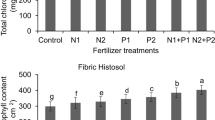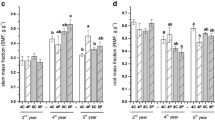Abstract
Rumex crispus (curled dock) and Rumex obtusifolius (broad leaved dock) are among the most problematic temperate zone perennial weeds of arable crops, abundant in a wide variety of conditions. Their root fragments, created during routine agricultural practices, are known to regenerate. Regeneration from two fragment weights and from different parts of the upper root and taproot was measured and compared between the species, in a winter field trial. A second field trial, which spanned winter into the following late spring, considered the effects of increasing the planting depths of root fragments. Biometric measures in both trials were above ground dry weight, leaf area, the number of shoots produced and below ground root fresh weight. From the first trial, total emergence was low in both species (31% in R. crispus and 37.5% in R. obtusifolius), tailed off quickly and only occurred from the upper or mid-root sections, with significant differences in emergence between species and the root fragment section, but not fragment starting sizes. The likelihood of plants emerging was significantly higher in R. obtusifolius and from the top root fragment section, growth from the root mid-section only occurred in R. obtusifolius. Root fragment starting weight made no significant difference. Rumex obtusifolius produced significantly less above ground dry weight, leaf area and shoots than R. crispus. More shoots were produced from larger root fragments in both species. In the winter to early summer trial both species showed weak early regeneration, which quickly tailed off, with R. crispus emerging in significantly greater numbers than R. obtusifolius. Notably, emergence resumed strongly the following spring-early summer in both species. Increasing soil depth was related to a significant decrease in emergence and impacted on all biometrics similarly, except fresh root weight which increased at moderate planting depths before tailing off. These findings confirm the potential for vegetative regeneration of both species, contribute to our understanding of factors influencing their regrowth and highlight key differences between them which can be used to improve control practices.





Similar content being viewed by others
References
Adolf G, Linke G (1992) Zur Biologie des Stumpfblattrigen Ampfers (Rumex obtusifolius L.). In: Martin-luther-universitat halle-writtenberg (eds) Efarungen und Ergebnisse bei der Bekampfung von Ampfer (Rumex obtusifolius L.) auf mehreren Grünlandstandorten unter praxisbedingungen. Martin-luther-universitat halle-writtenberg, Germany, 1–19
Allard RW (1965) Genetic systems associated with colonizing ability in predominantly self-pollinated species. In: baker, HG, Stebbins, GL (eds):the genetics of colonizing species. New York: academic press, pp 50–76. ISBN 012075150X 9780120751501
Alshallash K (2018) Emergence and root fragments regeneration of Rumex species. Annals of Agricultural Sciences 63:129–134. https://doi.org/10.1016/j.aoas.2018.08.001
Bolker B, R Development Core Team (2020) bbmle: Tools for General Maximum Likelihood Estimation. R package version 1.0.23.1. https://CRAN.R-project.org/package bbmle
Burnham KP, Anderson DR (2002) Model selection and inference: a practical information-theoretic approach. Springer, New York. https://doi.org/10.1007/b97636
Campbell I (2007) Chi-squared and Fisher-Irwin tests of two-by-two tables with small sample recommendations. Stat Med:2636613675. https://doi.org/10.1002/sim.2832
Cavanaugh JE, Neath AA (2019) The Akaike information criterion: background, derivation, properties, application, interpretation, and refinements. Wiley Interdisciplinary Reviews: Computational Statistics 11(3):e1460. https://doi.org/10.1002/wics.1460
Cavers PB, Harper JL (1964) Rumex obtusifolius L. and R. crispus L. J Ecol 52:737–766. https://doi.org/10.2307/2257859
Chapin FS, Schulze E, Mooney HA (1990) The Ecology and Economics of Storage in Plants Ann Rev Ecol Syst 21:423–447. https://doi.org/10.1146/annurev.es.21.110190.002231
Chytry M, Tichý L (2003) Diagnostic, constant and dominant species of vegetation classes and alliances of the Czech Republic: a statistical revision. Folia Fac Sci Nat Univ Masaryk Burn 108:1–231. ISBN 80-210-3221-9
Dierauer HU (1994) Efficiency of different non-chemical methods of controlling broadleaf dock (Rumex obtusifolius). In: Maîtrise des adventices par voie non chimique. Communications de la quatrième conférence internationale IFOAM, Dijon, France, 5–9 July 1993, Ed 2, pp 311–314, association Colloque IFOAM
Fletcher DJ, MacKenzie DI, Villouta E (2005) Modelling skewed data with many Zeros: a simple approach combining ordinary and logistic regression. Environ Ecol Stat 12:45–54. https://doi.org/10.1007/s10651-005-6817-1
Foster L (1989) The biology and non-chemical control of dock species Rumex obtusifolius and R. crispus. Biol Agric Hortic 6:11–25. https://doi.org/10.1080/01448765.1989.9754498
Gallery J (1989) Grünlandverunkrautung. Ursachen, Vorbeugung, Bekampfung. Leopold Stocker Verlag, Graz, Austria
Gwynne DC, Murray RB (1985) Weed biology and control in agriculture and horticulture. Batsford Academic and Educational. ISBN 0713435305
Haggar RJ (1980) Survey of the incidence of docks (Rumex spp.) in grassland in ten districts in the United Kingdom in 1972. ADAS Q rev 256–270
Hǻkansson S (2003) Weeds and weed management on arable land: an ecological approach. CABI publishing. https://doi.org/10.1079/9780851996516.0000
Hatcher PE (2017) Perennial Weeds, Weed Research: Expanding Horizons 389–412. ISBN 978-1-119-96914-3. doi:https://doi.org/10.1002/9781119380702.ch13
Hatcher PE, Melander B (2003) Combining physical, cultural and biological methods: prospects for integrated non-chemical weed management strategies. Weed Res 43:303–322. https://doi.org/10.1046/j.1365-3180.2003.00352.x
Hartig F (2020) DHARMa: residual diagnostics for hierarchical (multi-level / mixed) regression models, R package version 0.3.2.0. https://CRAN.R-project.org/package=DHARMa
Hejcman M, Strnad L, Hejcmanová P, Pavlů V (2014) Biological control of Rumex obtusifolius and Rumex crispus by goat grazing. Weed Biol Manag 14:115–120. https://doi.org/10.1111/wbm.12038
Hofmann F (1992) Der Stumpfblattrige Ampfer and Moglichkeiten seiner Bekampfing. In: Martin-luther-universitat halle-writtenberg (eds) Erfarungen und Ergebnisse bei der Bekampfung von Ampfer (Rumex obtusifolius L.) auf mehreren Grünlandstandorten unter praxisbedingungen 1–13. Martin-lutheruniversitat halle-writtenberg, Germany
Holm LG, Plucknett DL, Pancho JV, Herberger JP (1977) Rumex crispus and Rumex obtusifolius. In: Holm L (ed) The world’s worst weeds: distribution and biology. University of Hawaii Press, Honolulu, pp 401–408
Hongo A (1986) Infestation of Rumex obtusifolius L. and distribution pattern of its individual plants in sown grasslands in eastern Hokkaido. J Weed Science and Technology 31:300–305. 103719/weed.31.300
Hongo A (1989) Survival and growth of seedlings of Rumex obtusifolius L. and Rumex crispus L. in newly sown grassland. Weed Res 29:7–12. https://doi.org/10.1111/j.1365-3180.1989.tb00834.x
Hopkins A, Johnson R (2005) Effect of different manuring and defoliation patterns on broad-leaved dock (Rumex obtusifolius) in grassland. Annal of App Bio 140:255–262. https://doi.org/10.1111/j.1744-7348.2002.tb00179.x
Hunt LV, Harkess RD, (1968) Docks in grassland. Scottish Agric 47:160–162
Hurvich CM, Tsai CL (1993) A corrected Akaike information criterion for vector autoregressive model selection. J Time Ser Anal 14(3):271–279. https://doi.org/10.1111/j.1467-9892.1993.tb00144.x
Keary IP, Hatcher PE (2004) Combining competition from Lolium perenne and an insect–fungus combination to control Rumex obtusifolius seedlings. Weed Res 44:33–41. https://doi.org/10.1046/j.1365-3180.2003.00370.x
Klimes L (1993) Morphometry of leaves of Rumex crispus, R. obtusifolius and their hybrid (R. * pratensis). Preslia 65:219–224
McCarthy M, Spillane S, Walsh S, Kendon M (2016) The meteorology of the exceptional winter of 2015/2016 across the UK and Ireland. Weather 71(12):305–313. https://doi.org/10.1002/wea.2823
Merfield CN (2018) Non-chemical management of docks (Rumex). 07-2018. Lincoln New Zealand. The BHU Future Farming Centre
Met. Office, UK (2019) Available at: https://www.metoffice.gov.uk/binaries/content/assets/metofficegovuk/pdf/weather/learn-about/uk-past-events/interesting/2015/exceptional-warmth-december-2015%2D%2D-met-office.pdf. Accessed 09 October 2019
Monaco T, Cumbo E (1972) Growth and development of curly dock and broadleaf dock. Weed Sci 20:64–67. https://doi.org/10.1017/s0043174500034962
Pino J, Haggar RJ, Sans FX, Masalles RM, Hamilton RNS (1995) Clonal growth and fragment regeneration of Rumex obtusifolius L. Weed Res 35:141–148. https://doi.org/10.1111/j.1365-3180.1995.tb02027.x
Pino J, Sans FX, Masalles RM, Thomas JM, IFOAM (1994) the effect of periodical shoot removal on Rumex obtusifolius L. establishment in irrigated alfalfa (Medicago sativa L.) crops. In: Maitrise des adventices par voie non chimique. Communications de la quatrieme conference internationale IFOAM 2: 319–324. Association Colloque IFOAM
Pye A, Andersson L (2009) Time of emergence of Rumex crispus L. as affected by dispersal time, soil cover, and mechanical disturbance. Acta Agric Scand Sect B — Soil Plant Science 59:500–505. https://doi.org/10.1080/09064710802400547
Pye A, Andersson L, Fogelfors H (2011) Intense fragmentation and deep burial reduce emergence of Rumex crispus L. Acta Agriculture Scandinavia, Section B — Soil and Plant Science 61:431–437. https://doi.org/10.1080/09064710.2010.501764
R Core Team (2019) R: a language and environment for statistical computing. R Foundation for Statistical Computing, Vienna, Austria. https://www.R-project.org/
University of Reading, Reading Weather Data (2019) Available from: https://research.reading.ac.uk/meteorology/atmospheric-observatory/atmospheric-observatory-data/. Accessed 09 October 2019
Rhodes JR (2015) Mixture models for Overdispersed data. In: Fox GA, Negrete-Yankelevich S, Sosa VJ (eds) Ecological Statistics. Oxford University Press, Oxford, pp 378–381. https://doi.org/10.1093/acprof:oso/9780199672547.003.0013
Roberts E, Hughes R (1939) Biological studies in the control of docks (Rumex spp.). Welsh Journal of Agriculture 15:218–237
Stilmant D, Bodson B, Vrancken C, Losseau C (2010) Impact of cutting frequency on the vigour of Rumex obtusifolius. Grass Forage Sci 65:147–153. https://doi.org/10.1111/j.1365-2494.2010.00732.x
Venables WN, Ripley BD (2002) Modern applied statistics with S. Fourth Edition, Springer, New York. https://doi.org/10.1007/978-0-387-21706-2
Voigtlander G, Lang V, Kühbauch W (1976) Metabolism of reserve carbohydrates of Rumex obtusifolius and Polygonum bistorta. Landwirtsch Forsch 29:109–117
Welsh AH, Cunningham RB, Donnelly CF, Lindenmayer DB (1996) Modelling the abundance of rare species: statistical models for counts with extra zeros. Ecol Model 88:297–308. https://doi.org/10.1016/0304-3800(95)00113-1
Zaller JG (2004) Ecology and non-chemical control of Rumex crispus and R. obtusifolius (Polygonaceae): a review. Weed Res 44:414–432. https://doi.org/10.1111/j.1365-3180.2004.00416.x
Acknowledgments
Author expresses his thank to Dr. Paul E. Hatcher from School of Biological Sciences, University of Reading, UK for his valuable advices during this research work.
Author information
Authors and Affiliations
Corresponding author
Ethics declarations
Competing interests
Author declares no conflict of interest.
Additional information
Publisher’s note
Springer Nature remains neutral with regard to jurisdictional claims in published maps and institutional affiliations.
Rights and permissions
About this article
Cite this article
Alshallash, k.S. Rumex crispus and Rumex obtusifolius regeneration from root fragments is affected by fragment weight, root section and depth of planting. Biologia 76, 33–46 (2021). https://doi.org/10.2478/s11756-020-00600-0
Received:
Accepted:
Published:
Issue Date:
DOI: https://doi.org/10.2478/s11756-020-00600-0




